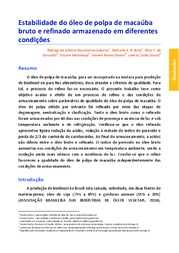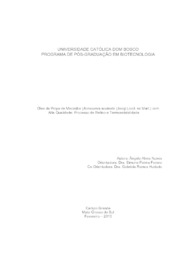Embrapa Agroenergy, in Brasília, DF, Brazil, and the National University of Asunción (UNA), in Paraguay, are developing in partnership a set of processes in order to extract macaw palm (Acrocomia aculeata) oil from its pulp. In the laboratory, scientists have already obtained good quality oil through environmentally sustainable methods and they were able to increase the volume of the extracted product by more than 50%. Also known as macaúba or bocaiúva in some places of Brazil, and mbokaja coconut in Paraguay, macaw palm can provide a great quality and high value oil. However, through conventional methods for its production, such as pressing, it is difficult to obtain quality oil, which restricts its use. Since July, the Paraguayan researchers Mario Smidt and Juan Daniel Rivaldi along with the Embrapa researcher Simone Palma Fávaro have carried out the extraction of macaw palm pulp oil from pilot plants in the laboratory. They did not use any processes with petroleum products and there was low energy expenditure, which guarantees environmental sustainability to the method. Smidt says that laboratory-scale methods were tested in the first experiments carried out at Embrapa Agroenergy, and currently pilot-plant scale trials are in progress. The macaw palm oil produced in Paraguay is mainly extracted by pressing its nut and pulp in a traditional way. As the fruit management after its harvest is not adequate, the pulp oil is of low quality. The researcher Simone Fávaro says because of this low quality, it cannot be raw material for biodiesel production. Oil volume increases more than 50% According to the researcher, both Paraguay and Brazil are interested in the processes being tested. In Paraguay, the commercially available mbokaja oil is mainly extracted from the nut, which accounts for only 25% of the fruit potential. With new extraction methods, oil production can be increased by more than 50% if pulp oil is included. "The partnership with Paraguay is helping us to complement the work with the industry's vision, which will also bring benefits for the macaw palm chain in Brazil", says Fávaro. The next step will be the test of the methods developed in an industrial-scale production. The processes are performed by equipment already used for extraction of other oils, but macaw palm, states the Embrapa researcher. "With the results of this work we intend to support initiatives of business implementation of macaw palm, taking advantage of the fruit in a more efficient way, generating greater economic viability with better quality products and production systems with low negative impact on the environment", emphasizes Fávaro. Macaw palm in cosmetics, foods and fuels The researcher says that the high quality of the oil will allow its application not only in biofuels, but also in other valuable segments of the market, such as cosmetics, foods and various others. "In Brazil, there are companies that import Paraguayan macaw palm nut oil to produce soap, other personal care products, and food. Nowadays the country has a production shortage of palm tree oil. Per year, it is imported 200,000 tons of palm oil, for instance. This is the size of the market only at the national level for macaw palm oil" says the Embrapa researcher. This is one of the research initiatives to tame macaw palm and make it a source of raw material for Brazilian agribusiness. In Brazil, the species is naturally found in all regions. Macaw palm Macaw palms’ wide dispersion in the Brazilian territory, especially in the areas of Cerrado and Pantanal, as well as some areas of the Semiarid region, guarantee their potential for the production of large quantities of oil per unit area, besides the possibility of use in integrated crop-livestock-forest systems (ICLFS). They may occupy production areas that are unsuitable for palm oil, now the world's leading source of plant oil, followed by soybeans. Research on the potential of these small coconuts reveals that they are a source of oil that can be used as raw material for the production of biodiesel and other products. Practically all parts of it are used: it serves as a raw material for cosmetics and drugs; the fruit is edible and the pulp is used in pastry and ice cream production; the endocarp (hard part of the coconut) is used for the production of activated carbon for filters and it can be used in steel industry; the nut is edible and has no toxic compounds. Potential productivity per macaw palm area is similar to that of palm oil: more than 4,000 liters of oil and 15 to 20 tons of fruit per hectare. Extractive production The exploitation of macaw palm in Brazil and Paraguay, however, is still focused on extractivism. Paraguay is different because it already has a large-scale industrial park that has processed macaw palm for more than 80 years. Currently, around 5,000,000 tons of fruit are processed in Paraguay, resulting in 2.5 tons of nut oil and 0.5 ton of pulp oil. The low yield in pulp oil is due to harvest, in which they remove green fruit bunches, and to rudimentary processing. With proper managing and industrialization, researchers estimate that more than 6 tons of pulp oil could be obtained. Adequate practices for the preservation of the species are fundamental to guarantee genetic variability, a fundamental characteristic for breeding programs aimed at the domestication and obtaining of commercial cultivars. Embrapa Agroenergy, in partnership with other Embrapa Units and private institutions, develops studies on genetic improvement, management and cultural treatments and industrial processes of conversion of oils into products of economic interest to consolidate macaw palm as one of the raw materials in the production chain of biodiesel. It also maintains germplasm banks for the conservation of genetic variability of the species. Translation: Ana Maranhão Nogueira
Photo: Daniela Collares

Researchers have developed methods that increase the volume of produced oil maintaining its quality
Embrapa Agroenergy, in Brasília, DF, Brazil, and the National University of Asunción (UNA), in Paraguay, are developing in partnership a set of processes in order to extract macaw palm (Acrocomia aculeata) oil from its pulp. In the laboratory, scientists have already obtained good quality oil through environmentally sustainable methods and they were able to increase the volume of the extracted product by more than 50%.
Also known as macaúba or bocaiúva in some places of Brazil, and mbokaja coconut in Paraguay, macaw palm can provide a great quality and high value oil. However, through conventional methods for its production, such as pressing, it is difficult to obtain quality oil, which restricts its use.
Since July, the Paraguayan researchers Mario Smidt and Juan Daniel Rivaldi along with the Embrapa researcher Simone Palma Fávaro have carried out the extraction of macaw palm pulp oil from pilot plants in the laboratory. They did not use any processes with petroleum products and there was low energy expenditure, which guarantees environmental sustainability to the method.
Smidt says that laboratory-scale methods were tested in the first experiments carried out at Embrapa Agroenergy, and currently pilot-plant scale trials are in progress.
The macaw palm oil produced in Paraguay is mainly extracted by pressing its nut and pulp in a traditional way. As the fruit management after its harvest is not adequate, the pulp oil is of low quality. The researcher Simone Fávaro says because of this low quality, it cannot be raw material for biodiesel production.
Oil volume increases more than 50%
According to the researcher, both Paraguay and Brazil are interested in the processes being tested. In Paraguay, the commercially available mbokaja oil is mainly extracted from the nut, which accounts for only 25% of the fruit potential. With new extraction methods, oil production can be increased by more than 50% if pulp oil is included. "The partnership with Paraguay is helping us to complement the work with the industry's vision, which will also bring benefits for the macaw palm chain in Brazil", says Fávaro.
The next step will be the test of the methods developed in an industrial-scale production. The processes are performed by equipment already used for extraction of other oils, but macaw palm, states the Embrapa researcher.
"With the results of this work we intend to support initiatives of business implementation of macaw palm, taking advantage of the fruit in a more efficient way, generating greater economic viability with better quality products and production systems with low negative impact on the environment", emphasizes Fávaro.
Macaw palm in cosmetics, foods and fuels
The researcher says that the high quality of the oil will allow its application not only in biofuels, but also in other valuable segments of the market, such as cosmetics, foods and various others. "In Brazil, there are companies that import Paraguayan macaw palm nut oil to produce soap, other personal care products, and food. Nowadays the country has a production shortage of palm tree oil. Per year, it is imported 200,000 tons of palm oil, for instance. This is the size of the market only at the national level for macaw palm oil" says the Embrapa researcher.
This is one of the research initiatives to tame macaw palm and make it a source of raw material for Brazilian agribusiness. In Brazil, the species is naturally found in all regions.
Macaw palm Macaw palms’ wide dispersion in the Brazilian territory, especially in the areas of Cerrado and Pantanal, as well as some areas of the Semiarid region, guarantee their potential for the production of large quantities of oil per unit area, besides the possibility of use in integrated crop-livestock-forest systems (ICLFS). They may occupy production areas that are unsuitable for palm oil, now the world's leading source of plant oil, followed by soybeans.
Research on the potential of these small coconuts reveals that they are a source of oil that can be used as raw material for the production of biodiesel and other products. Practically all parts of it are used: it serves as a raw material for cosmetics and drugs; the fruit is edible and the pulp is used in pastry and ice cream production; the endocarp (hard part of the coconut) is used for the production of activated carbon for filters and it can be used in steel industry; the nut is edible and has no toxic compounds.
Potential productivity per macaw palm area is similar to that of palm oil: more than 4,000 liters of oil and 15 to 20 tons of fruit per hectare. Extractive production The exploitation of macaw palm in Brazil and Paraguay, however, is still focused on extractivism. Paraguay is different because it already has a large-scale industrial park that has processed macaw palm for more than 80 years. Currently, around 5,000,000 tons of fruit are processed in Paraguay, resulting in 2.5 tons of nut oil and 0.5 ton of pulp oil. The low yield in pulp oil is due to harvest, in which they remove green fruit bunches, and to rudimentary processing. With proper managing and industrialization, researchers estimate that more than 6 tons of pulp oil could be obtained.
Adequate practices for the preservation of the species are fundamental to guarantee genetic variability, a fundamental characteristic for breeding programs aimed at the domestication and obtaining of commercial cultivars.
Embrapa Agroenergy, in partnership with other Embrapa Units and private institutions, develops studies on genetic improvement, management and cultural treatments and industrial processes of conversion of oils into products of economic interest to consolidate macaw palm as one of the raw materials in the production chain of biodiesel. It also maintains germplasm banks for the conservation of genetic variability of the species. |
Translation: Ana Maranhão Nogueira
Daniela Collares (MTb 114/01 RR)
Embrapa Agroenergy
Press inquiries
agroenergia.imprensa@embrapa.br
Phone number: +55 61 3448-1581
Mariana Medeiros (Translation - English)
General Secretariat
Further information on the topic
Citizen Attention Service (SAC)
www.embrapa.br/contact-us/sac/



